Cattle Abortions and Congenital Malformations Due to Bluetongue Virus Serotype 3 in Southern Belgium, 2024
Abstract
1. Introduction
2. Materials and Methods
2.1. Study Design and Passive Monitoring System
2.2. Laboratory Analyses
2.2.1. Analyses on Necropsied Animals Including Foetuses
2.2.2. Analyses on Living Animals
2.3. Statistical Analyses
3. Results
3.1. Clinical Presentation
3.2. Monitoring of BTV Using the Abortion Protocol
4. Discussion
5. Conclusions
Author Contributions
Funding
Institutional Review Board Statement
Data Availability Statement
Acknowledgments
Conflicts of Interest
Appendix A
| Abortions Without Congenital Lesions in Function of the Age of the Fœtus in Months | Abortions With Congenital Lesions in Function of the Age of the Fœtus in Months | |||||||||||||||||||||
|---|---|---|---|---|---|---|---|---|---|---|---|---|---|---|---|---|---|---|---|---|---|---|
| Month of the Year | 1 | 2 | 3 | 4 | 5 | 6 | 7 | 8 | 9 | ? | Total | 1 | 2 | 3 | 4 | 5 | 6 | 7 | 8 | 9 | ? | Total |
| 1 | 1 | 11 | 33 | 71 | 117 | 124 | 212 | 569 | 1 | 1 | 6 | 8 | ||||||||||
| 2 | 5 | 7 | 23 | 63 | 76 | 98 | 249 | 4 | 525 | 1 | 10 | 11 | ||||||||||
| 3 | 2 | 1 | 6 | 13 | 42 | 56 | 80 | 212 | 3 | 415 | 1 | 10 | 11 | |||||||||
| 4 | 3 | 9 | 16 | 45 | 47 | 81 | 156 | 2 | 359 | 2 | 16 | 18 | ||||||||||
| 5 | 2 | 2 | 7 | 14 | 24 | 38 | 43 | 109 | 3 | 242 | 2 | 5 | 7 | |||||||||
| 6 | 2 | 4 | 15 | 19 | 29 | 33 | 78 | 1 | 181 | 1 | 1 | 3 | 5 | |||||||||
| 7 | 1 | 2 | 13 | 28 | 42 | 34 | 75 | 1 | 196 | 2 | 3 | 5 | ||||||||||
| 8 | 1 | 4 | 23 | 76 | 80 | 65 | 154 | 209 | 2 | 614 | 2 | 8 | 2 | 4 | 16 | |||||||
| 9 | 1 | 7 | 22 | 43 | 85 | 76 | 131 | 279 | 2 | 646 | 14 | 50 | 58 | 42 | 20 | 35 | 1 | 220 | ||||
| 10 | 13 | 17 | 17 | 37 | 55 | 85 | 206 | 430 | 1 | 6 | 15 | 50 | 42 | 31 | 44 | 189 | ||||||
| 11 | 6 | 7 | 21 | 39 | 27 | 64 | 130 | 3 | 297 | 4 | 9 | 29 | 35 | 31 | 41 | 1 | 150 | |||||
| 12 | 1 | 7 | 10 | 24 | 66 | 64 | 80 | 119 | 3 | 374 | 8 | 35 | 33 | 46 | 138 | 3 | 263 | |||||
| Total | 0 | 8 | 51 | 125 | 308 | 599 | 692 | 1007 | 2034 | 24 | 4848 | 0 | 0 | 1 | 24 | 84 | 180 | 159 | 135 | 315 | 5 | 903 |
Appendix B

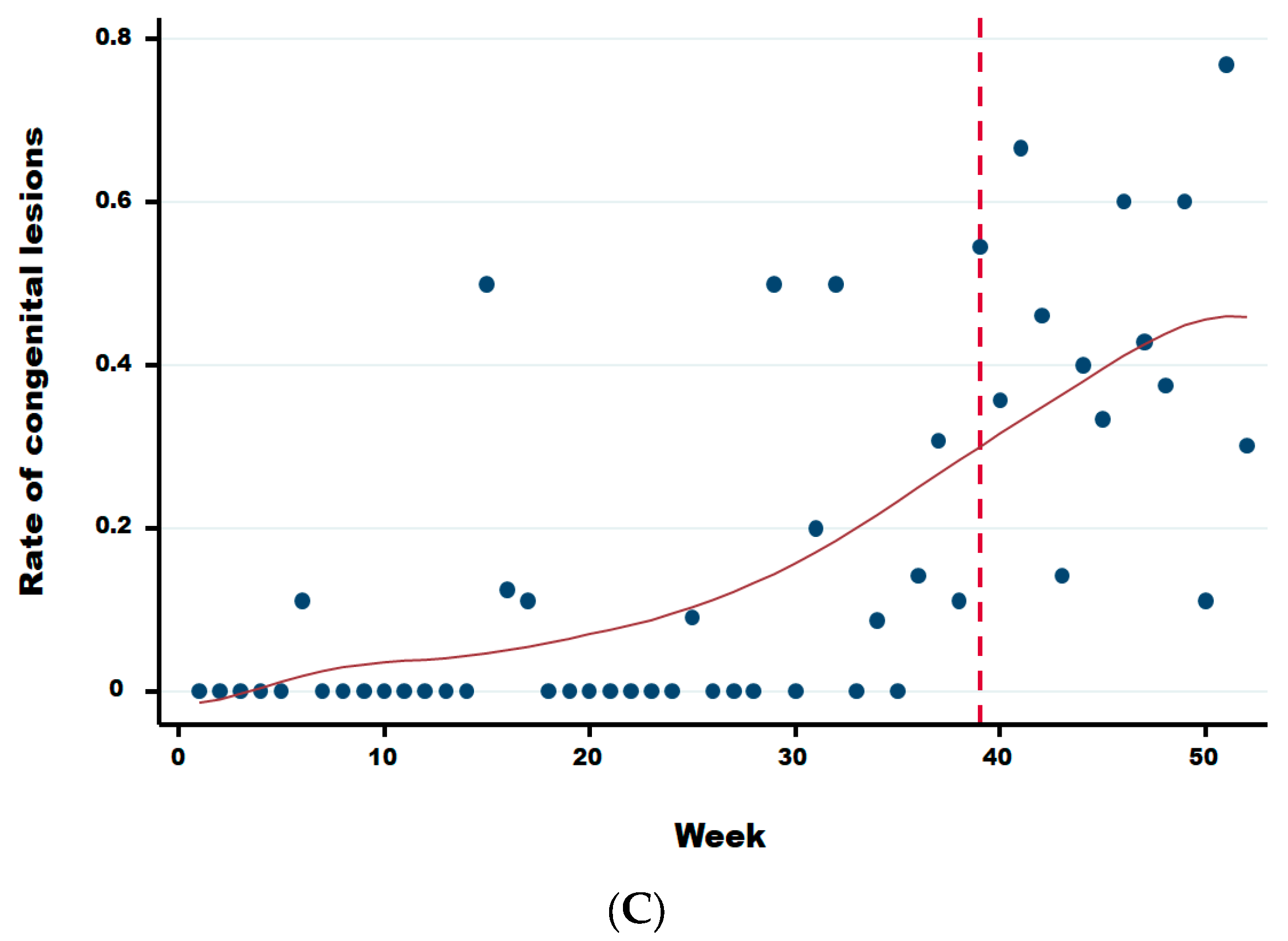
References
- Van Leeuw, V.; De Leeuw, I.; Degives, N.; Depoorter, P.; Dewulf, J.; Hanon, J.-B.; Hooyberghs, J.; Linden, A.; Praet, L.; Raemaekers, M.; et al. Impact of BTV-3 Circulation in Belgium in 2024 and Current Knowledge Gaps Hindering an Evidence-Based Control Program. Viruses 2025, 17, 521. [Google Scholar] [CrossRef] [PubMed]
- Saegerman, C.; Berkvens, D.; Mellor, P.S. Bluetongue epidemiology in the European Union. Emerg. Infect. Dis. 2008, 14, 539–544. [Google Scholar] [CrossRef] [PubMed]
- Zientara, S.; Sánchez-Vizcaíno, J.M. Control of bluetongue in Europe. Vet. Microbiol. 2013, 165, 33–37. [Google Scholar] [CrossRef] [PubMed]
- Holwerda, M.; Santman-Berends, I.M.; Harders, F.; Engelsma, M.; Vloet, R.P.; Dijkstra, E.; van Gennip, R.G.; Mars, M.H.; Spierenburg, M.; Roos, L.; et al. Emergence of Bluetongue Virus Serotype 3, the Netherlands, September 2023. Emerg. Infect. Dis. 2024, 30, 1552–1561. [Google Scholar] [CrossRef]
- Voigt, A.; Kampen, H.; Heuser, E.; Zeiske, S.; Hoffmann, B.; Höper, D.; Holsteg, M.; Sick, F.; Ziegler, S.; Wernike, K.; et al. Bluetongue Virus Serotype 3 and Schmallenberg Virus in Culicoides Biting Midges, Western Germany, 2023. Emerg. Infect. Dis. 2024, 30, 1438–1441. [Google Scholar] [CrossRef]
- DEFRA (Department for Environment, Food & Rural Affairs). Disease Control Framework for Bluetongue Virus Serotype 3 in England in 2024. Consulted 08/05/2025. 22 May 2024. Available online: https://www.gov.uk/government/publications/bluetongue-disease-control-framework-in-england/disease-control-framework-for-bluetongue-virus-serotype-3-in-england-in-2024 (accessed on 8 May 2025).
- Kopanke, J.; Lee, J.; Stenglein, M.; Carpenter, M.; Cohnstaedt, L.W.; Wilson, W.C.; Mayo, C. Exposure of Culicoides sonorensis to Enzootic Strains of Bluetongue Virus Demonstrates Temperature- and Virus-Specific Effects on Virogenesis. Viruses 2021, 13, 1016. [Google Scholar] [CrossRef]
- Mellor, P.S.; Boorman, J.; Baylis, M. Culicoides biting midges: Their role as arbovirus vectors. Annu. Rev. Èntomol. 2000, 45, 307–340. [Google Scholar] [CrossRef]
- Sick, F.; Beer, M.; Kampen, H.; Wernike, K. Culicoides Biting Midges—Underestimated Vectors for Arboviruses of Public Health and Veterinary Importance. Viruses 2019, 11, 376. [Google Scholar] [CrossRef]
- Zeiske, S.; Sick, F.; Kampen, H.; Hoffmann, B.; Beer, M.; Wernike, K. Experimental BTV-3 and BTV-8 infection of Culicoides sonorensis biting midges. Parasites Vectors 2025, 18, 234. [Google Scholar] [CrossRef]
- Hudson, A.R.; McGregor, B.L.; Shults, P.; England, M.; Silbernagel, C.; Mayo, C.; Carpenter, M.; Sherman, T.J.; Cohnstaedt, L.W. Culicoides-borne Orbivirus epidemiology in a changing climate. J. Med. Èntomol. 2023, 60, 1221–1229. [Google Scholar] [CrossRef]
- MacLachlan, N.J. The changing global face of Bluetongue: From the beginning. Vet. Ital. 2015, 51, 249–251. [Google Scholar] [CrossRef] [PubMed]
- European Commission. Commission Implementing Regulation (EU) 2020/2002 of 7 December 2020 laying down rules for the application of Regulation (EU) 2016/429 of the European Parliament and of the Council as regards surveillance, eradication programmes and disease-free status for certain listed diseases. Off. J. Eur. Union 2020, L 412, 1–54. [Google Scholar]
- Van Loo, H.; Pascottini, O.B.; Ribbens, S.; Hooyberghs, J.; Opsomer, G.; Pardon, B. Enhancing bovine abortion surveillance: A learning experience. J. Dairy Sci. 2024, 107, 1766–1777. [Google Scholar] [CrossRef] [PubMed]
- Agerholm, J.S.; Hewicker-Trautwein, M.; Peperkamp, K.; Windsor, P.A. Virus-induced congenital malformations in cattle. Acta Vet. Scand. 2015, 57, 54. [Google Scholar] [CrossRef]
- Maclachlan, N.J.; Mayo, C.E.; Daniels, P.W.; Savini, G.; Zientara, S.; Gibbs, E.P. Bluetongue. Rev. Sci. Tech. 2015, 34, 329–340. [Google Scholar] [CrossRef]
- Vercauteren, G.; Miry, C.; Vandenbussche, F.; Ducatelle, R.; Van der Heyden, S.; Vandemeulebroucke, E.; De Leeuw, I.; Deprez, P.; Chiers, K.; De Clercq, K. Bluetongue virus serotype 8-associated congenital hydranencephaly in calves. Transbound. Emerg. Dis. 2008, 55, 293–298. [Google Scholar] [CrossRef]
- Zanella, G.; Durand, B.; Sellal, E.; Breard, E.; Sailleau, C.; Zientara, S.; Batten, C.; Mathevet, P.; Audeval, C. Bluetongue virus serotype 8: Abortion and transplacental transmission in cattle in the Burgundy region, France, 2008–2009. Theriogenology 2012, 77, 65–72. [Google Scholar] [CrossRef]
- Coetzee, P.; van Vuuren, M.; Venter, E.H.; Stokstad, M. A review of experimental infections with bluetongue virus in the mammalian host. Virus Res. 2014, 182, 21–34. [Google Scholar] [CrossRef]
- Vandenbussche, F.; De Leeuw, I.; Vandemeulebroucke, E.; De Clercq, K. Emergence of bluetongue serotypes in EUROPE, part 1: Description and validation of four real-time RT-PCR assays for the serotyping of bluetongue viruses BTV-1, BTV-6, BTV-8 and BTV-11. Transbound. Emerg. Dis. 2009, 56, 346–354. [Google Scholar] [CrossRef]
- Ditzen, J.; Karavias, Y.; Westerlund, J. Testing and Estimating Structural Breaks in Time Series and Panel Data in Stata. Stata J. Promot. Commun. Stat. Stata 2025, 25, 526–560. [Google Scholar] [CrossRef]
- Cleveland, W.S. Robust locally weighted regression and smoothing scatterplots. J. Am. Stat. Assoc. 1979, 74, 829–836. [Google Scholar] [CrossRef]
- Martinelle, L.; Pozzo, F.D.; Thiry, E.; De Clercq, K.; Saegerman, C. Reliable and Standardized Animal Models to Study the Pathogenesis of Bluetongue and Schmallenberg Viruses in Ruminant Natural Host Species with Special Emphasis on Placental Crossing. Viruses 2019, 11, 753. [Google Scholar] [CrossRef] [PubMed]
- Bibard, A.; Martinetti, D.; Giraud, A.; Picado, A.; Chalvet-Monfray, K.; Porphyre, T. Quantitative risk assessment for the introduction of bluetongue virus into mainland Europe by long-distance wind dispersal of Culicoides spp.: A case study from Sardinia. Risk Anal. 2024, 45, 108–127. [Google Scholar] [CrossRef] [PubMed]
- Mayo, C.E.; Mullens, B.A.; Reisen, W.K.; Osborne, C.J.; Gibbs, E.P.J.; Gardner, I.A.; MacLachlan, N.J. Seasonal and Interseasonal Dynamics of Bluetongue Virus Infection of Dairy Cattle and Culicoides sonorensis Midges in Northern California—Implications for Virus Overwintering in Temperate Zones. PLoS ONE 2014, 9, e106975. [Google Scholar] [CrossRef] [PubMed]
- Losson, B.; Mignon, B.; Paternostre, J.; Madder, M.; De Deken, R.; De Deken, G.; Deblauwe, I.; Fassotte, C.; Cors, R.; Defrance, T.; et al. Biting midges overwintering in Belgium. Vet. Rec. 2007, 160, 451–452. [Google Scholar] [CrossRef]
- Baetza, H.-J. Eradication of bluetongue disease in Germany by vaccination. Vet. Immunol. Immunopathol. 2014, 158, 116–119. [Google Scholar] [CrossRef]
- Subhadra, S.; Sreenivasulu, D.; Pattnaik, R.; Panda, B.K.; Kumar, S. Bluetongue virus: Past, present, and future scope. J. Infect. Dev. Ctries. 2023, 17, 147–156. [Google Scholar] [CrossRef]
- Saegerman, C.; Bolkaerts, B.; Baricalla, C.; Raes, M.; Wiggers, L.; de Leeuw, I.; Vandenbussche, F.; Zimmer, J.-Y.; Haubruge, E.; Cassart, D.; et al. The impact of naturally-occurring, trans-placental bluetongue virus serotype-8 infection on reproductive performance in sheep. Vet. J. 2011, 187, 72–80. [Google Scholar] [CrossRef]
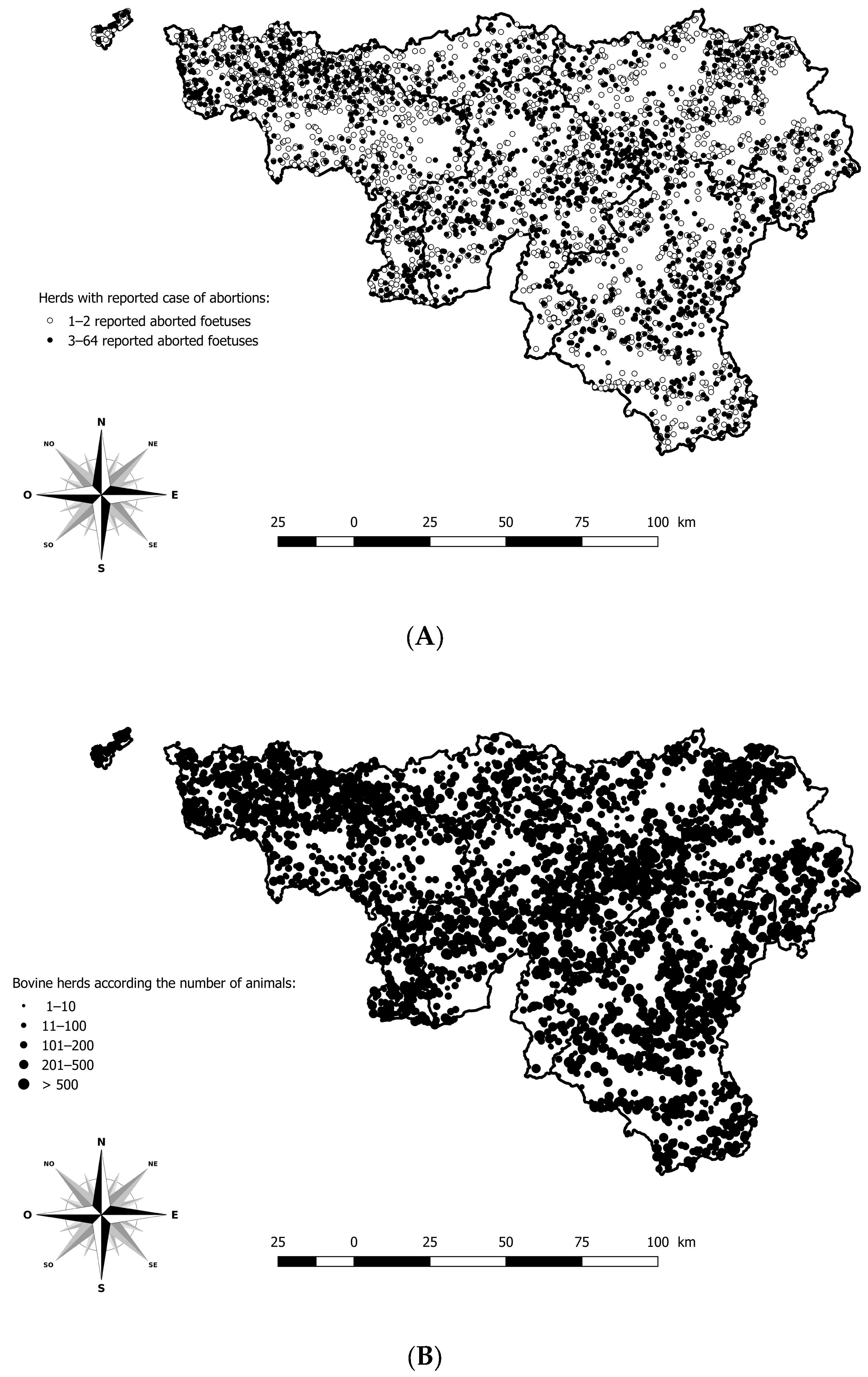
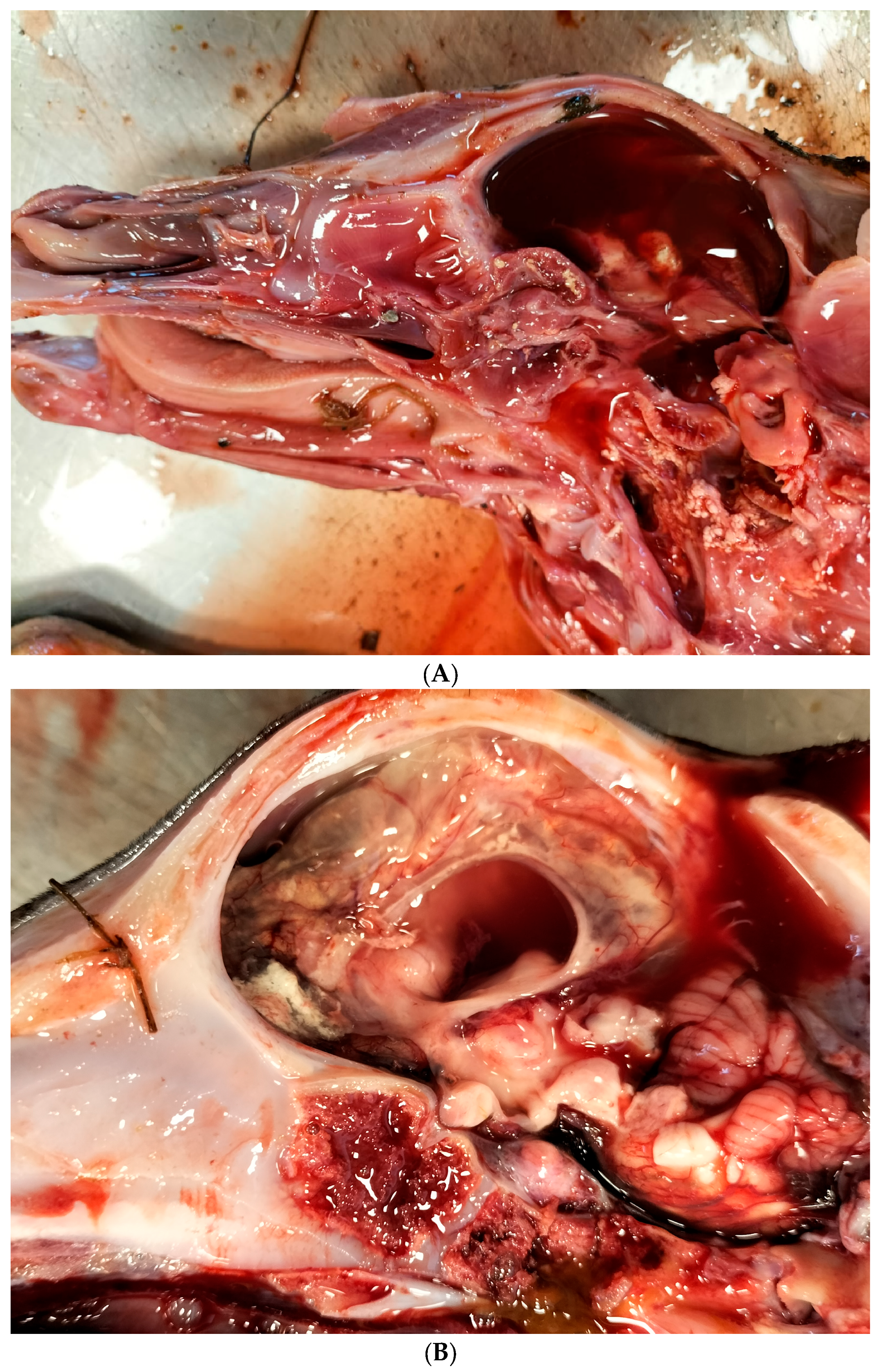


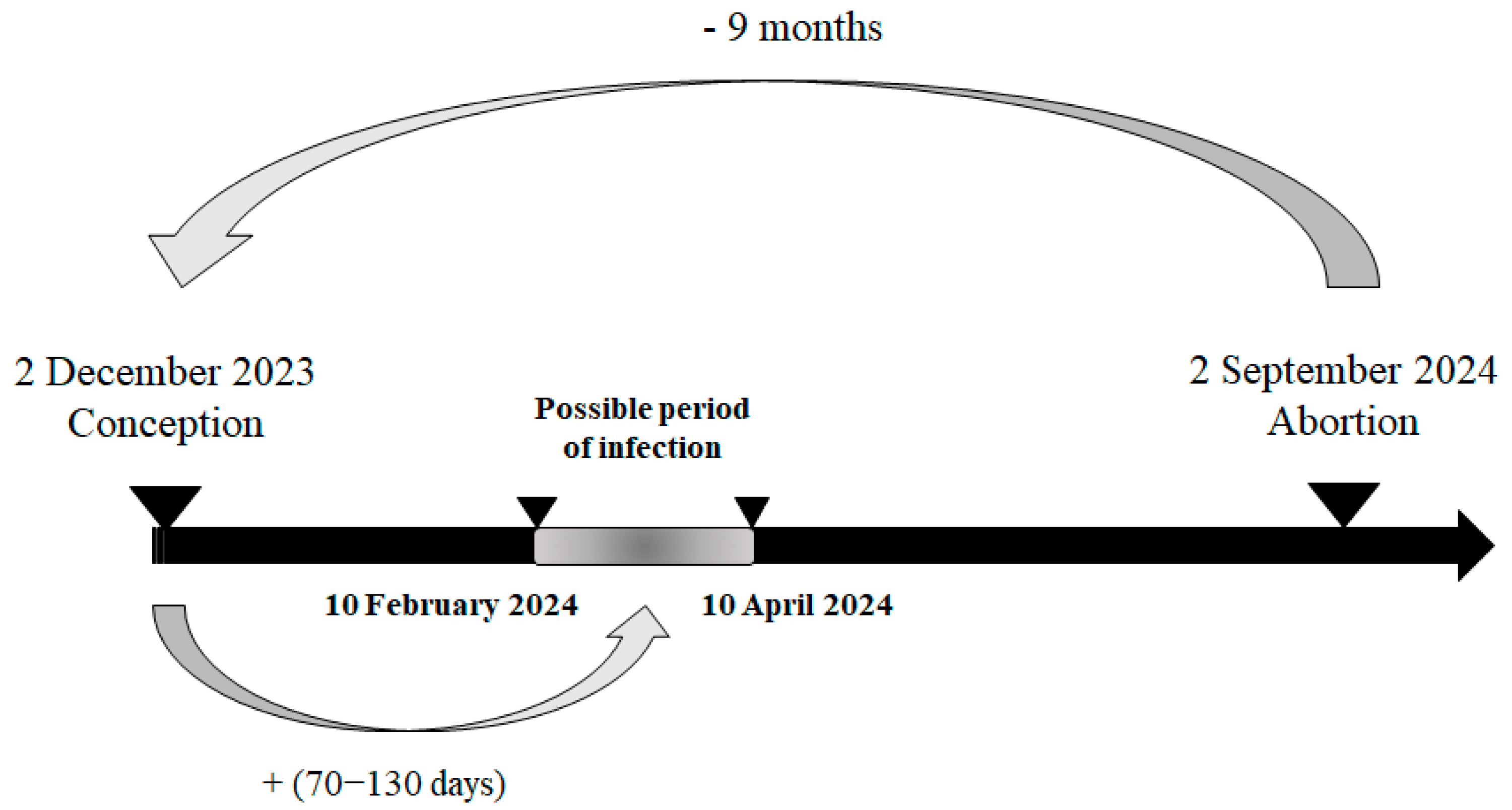

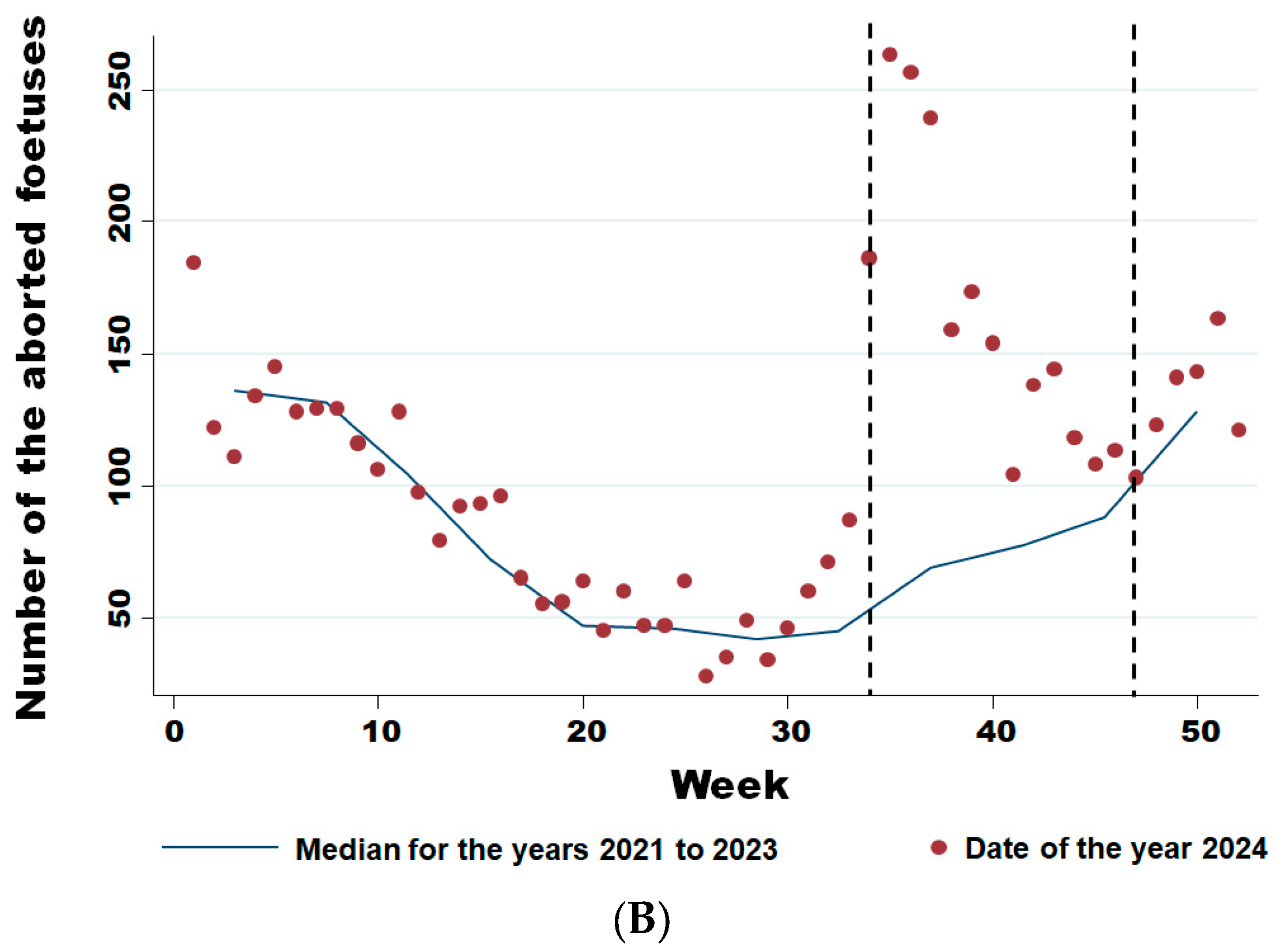
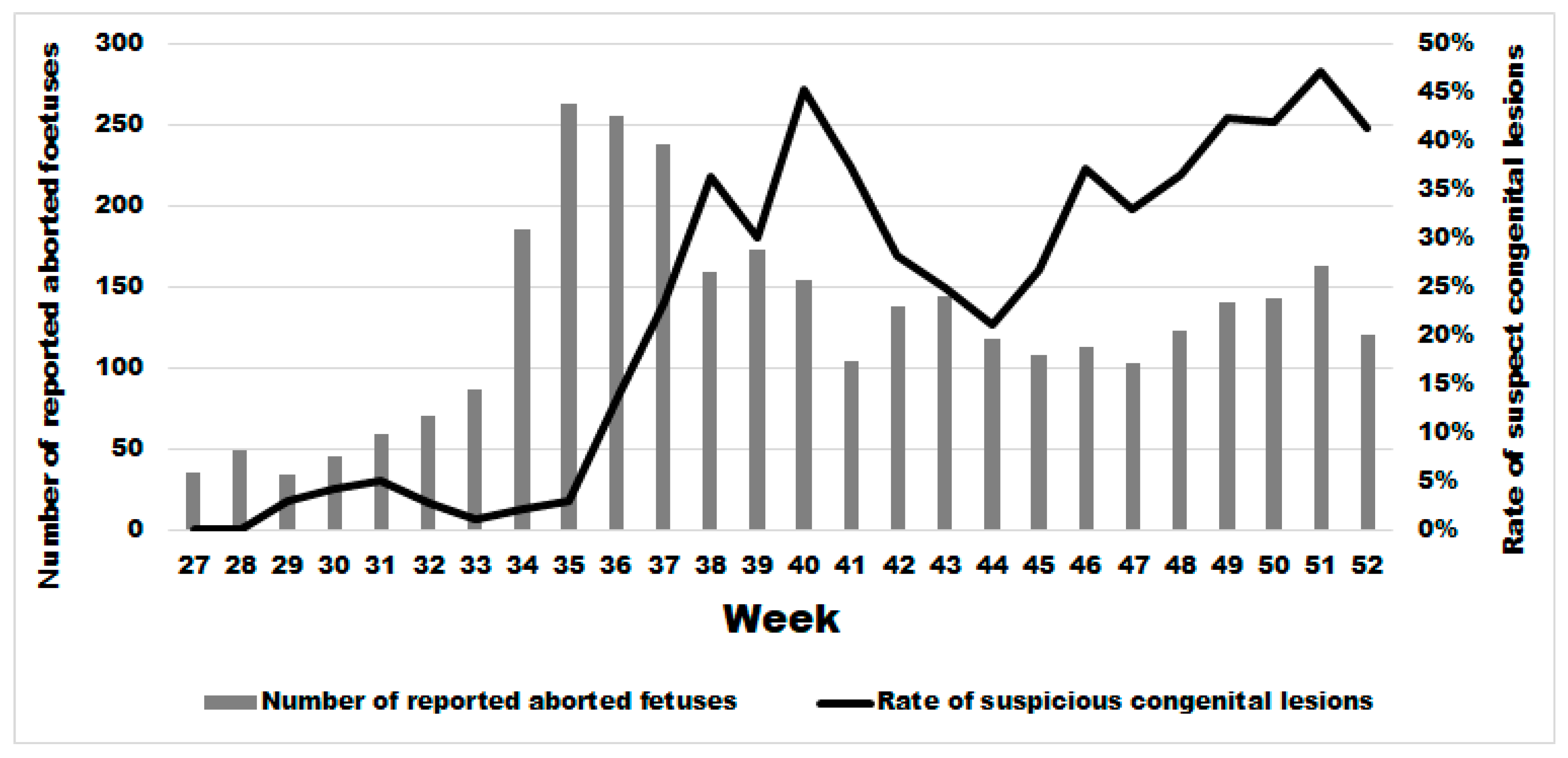
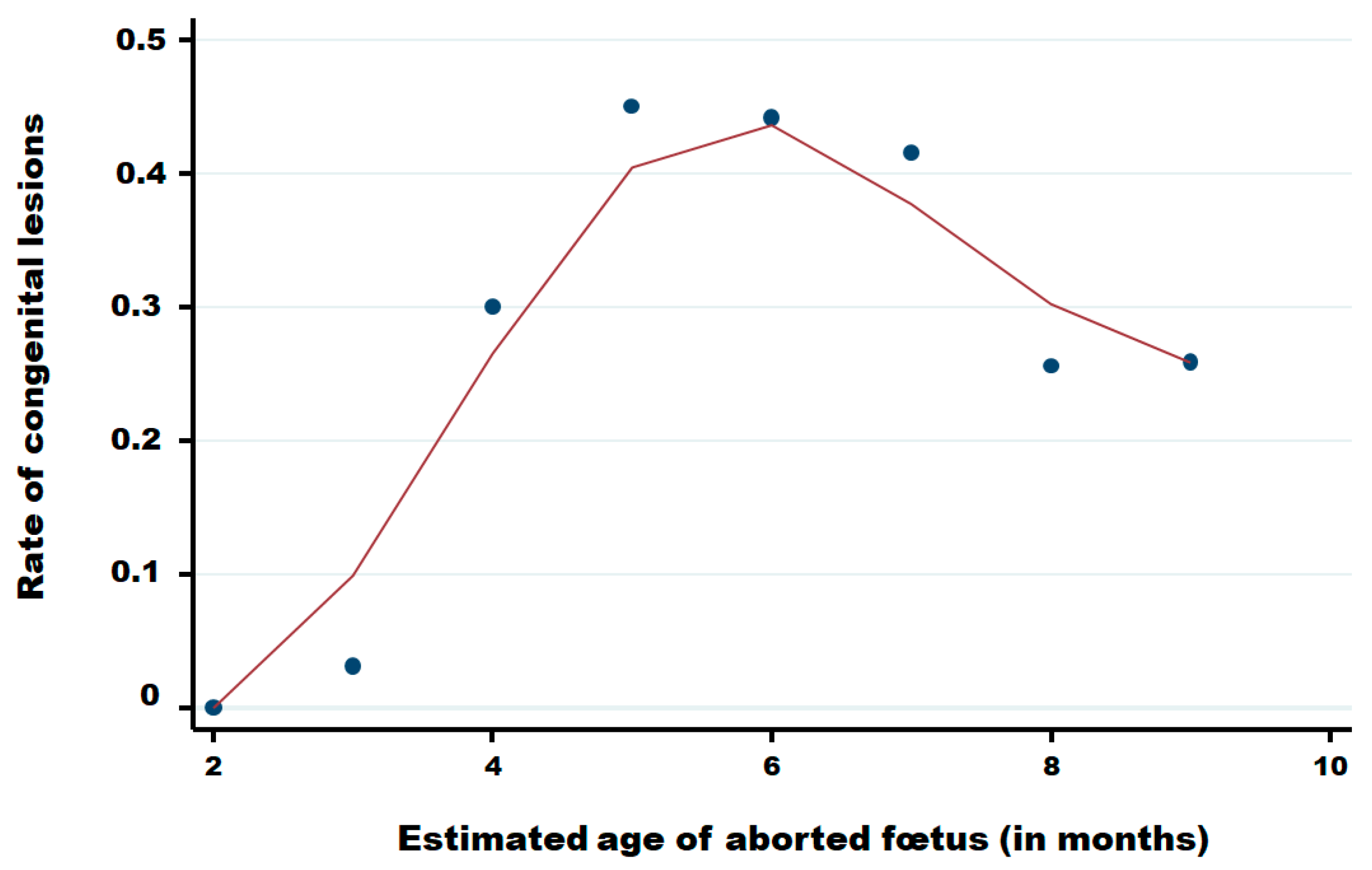
| Number of Herds with Minimum One Reported Abortion Cases | Nb of Reported Abortion Cases | Average Number of Aborted Foetuses by Herds | |
|---|---|---|---|
| 2021 | 2341 | 4646 | 1.98 |
| 2022 | 2136 | 3997 | 1.87 |
| 2023 | 2239 | 4301 | 1.92 |
| 2024 | 2643 | 5751 | 2.18 |
| TOTAL | 9359 | 18,695 | 2.00 |
| Pathogens | Foetus | Foetal Serum | Maternal Serum | |
|---|---|---|---|---|
| Samples | Methods | Methods | Methods | |
| Anaplasma phagocytophilum Brucella spp. | Spleen Abomasal fluid | PCR *** Culture | SAW/ELISA Ab | |
| Campylobacter foetus spp. | Abomasal fluid | Culture | ||
| Coxiella burnetii | Abomasal fluid | PCR ** | ELISA Ab | |
| Listeria monocytogenes | Abomasal fluid | Culture | ||
| Mycotic agents | Abomasal fluid | Culture | ||
| Opportunistic bacteria | Abomasal fluid | Culture $ | ||
| Salmonella spp. | Abomasal fluid | Culture | ||
| BTV (Serotype 3 or 8) | Spleen | PCR * | ||
| Neospora caninum | Brain | PCR | ELISA Ab | ELISA Ab |
| Schmallenberg virus | Brain | PCR * | ||
| BoHV-4 | Spleen | PCR | ELISA Ab | |
| BVDV | Spleen | ELISA Ag | ELISA Ab | |
| Leptospira serovar Hardjo | Spleen | PCR * | ELISA Ab | |
| Absence of Congenital Lesions of the CNS | Presence of Congenital Lesions of the CNS | |||||||
|---|---|---|---|---|---|---|---|---|
| Month | Without PCR | With Negative PCR | With Positive PCR | Total | Without PCR | With Negative PCR | With Positive PCR | Total |
| January 2024 | 566 | 3 | 569 | 8 | 8 | |||
| February 2024 | 521 | 4 | 525 | 11 | 11 | |||
| March 2024 | 405 | 10 | 415 | 11 | 11 | |||
| April 2024 | 350 | 9 | 359 | 18 | 18 | |||
| May 2024 | 238 | 4 | 242 | 7 | 7 | |||
| June 2024 | 180 | 1 | 181 | 5 | 5 | |||
| July 2024 | 192 | 4 | 196 | 5 | 5 | |||
| August 2024 | 545 | 27 | 42 | 614 | 4 | 12 | 16 | |
| September 2024 | 585 | 17 | 44 | 646 | 111 | 13 | 96 | 220 |
| October 2024 | 361 | 19 | 50 | 430 | 137 | 6 | 46 | 189 |
| November 2024 | 262 | 15 | 20 | 297 | 134 | 4 | 12 | 150 |
| December 2024 | 334 | 36 | 4 | 374 | 230 | 11 | 22 | 263 |
| Total | 4539 | 149 | 160 | 4848 | 612 | 103 | 188 | 903 |
| Absence of Congenital Lesions | Presence of Congenital Lesions | |||||||
|---|---|---|---|---|---|---|---|---|
| Estimated Gestational Stage (Month) | Without PCR | With Negative PCR | With Positive PCR | Total | Without PCR | With Negative PCR | With Positive PCR | Total |
| Unknown | 8 | 0 | 0 | 8 | 5 | 0 | 0 | 5 |
| 2 | 2 | 0 | 0 | 2 | 0 | 0 | 0 | 0 |
| 3 | 25 | 2 | 4 | 31 | 0 | 0 | 1 | 1 |
| 4 | 53 | 2 | 1 | 56 | 18 | 1 | 5 | 24 |
| 5 | 84 | 7 | 9 | 100 | 52 | 1 | 29 | 82 |
| 6 | 193 | 14 | 6 | 213 | 121 | 8 | 40 | 169 |
| 7 | 191 | 11 | 8 | 210 | 107 | 7 | 36 | 150 |
| 8 | 306 | 12 | 29 | 347 | 95 | 4 | 21 | 120 |
| 9 | 634 | 32 | 61 | 727 | 200 | 13 | 42 | 255 |
| Total | 1496 | 80 | 118 | 1694 | 598 | 34 | 174 | 806 |
| Before 01/08/2024 | After 01/08/2024 | |||||
|---|---|---|---|---|---|---|
| Cattle Breed | Absence of Congenital Lesions | Congenital Lesions | Total | Absence of Congenital Lesions | Congenital Lesions | Total |
| Unknown | 512 | 5 | 517 | 66 | 25 | 91 |
| Meat | 10,678 | 197 | 10,875 | 1509 | 475 | 1984 |
| Milk | 3152 | 51 | 3203 | 615 | 264 | 879 |
| Mixed | 880 | 21 | 901 | 155 | 73 | 228 |
| Total | 15,222 | 274 | 15,496 | 2345 | 837 | 3182 |
Disclaimer/Publisher’s Note: The statements, opinions and data contained in all publications are solely those of the individual author(s) and contributor(s) and not of MDPI and/or the editor(s). MDPI and/or the editor(s) disclaim responsibility for any injury to people or property resulting from any ideas, methods, instructions or products referred to in the content. |
© 2025 by the authors. Licensee MDPI, Basel, Switzerland. This article is an open access article distributed under the terms and conditions of the Creative Commons Attribution (CC BY) license (https://creativecommons.org/licenses/by/4.0/).
Share and Cite
Delooz, L.; De Regge, N.; De Leeuw, I.; Smeets, F.; Petitjean, T.; Grégoire, F.; Saegerman, C. Cattle Abortions and Congenital Malformations Due to Bluetongue Virus Serotype 3 in Southern Belgium, 2024. Viruses 2025, 17, 1356. https://doi.org/10.3390/v17101356
Delooz L, De Regge N, De Leeuw I, Smeets F, Petitjean T, Grégoire F, Saegerman C. Cattle Abortions and Congenital Malformations Due to Bluetongue Virus Serotype 3 in Southern Belgium, 2024. Viruses. 2025; 17(10):1356. https://doi.org/10.3390/v17101356
Chicago/Turabian StyleDelooz, Laurent, Nick De Regge, Ilse De Leeuw, Frédéric Smeets, Thierry Petitjean, Fabien Grégoire, and Claude Saegerman. 2025. "Cattle Abortions and Congenital Malformations Due to Bluetongue Virus Serotype 3 in Southern Belgium, 2024" Viruses 17, no. 10: 1356. https://doi.org/10.3390/v17101356
APA StyleDelooz, L., De Regge, N., De Leeuw, I., Smeets, F., Petitjean, T., Grégoire, F., & Saegerman, C. (2025). Cattle Abortions and Congenital Malformations Due to Bluetongue Virus Serotype 3 in Southern Belgium, 2024. Viruses, 17(10), 1356. https://doi.org/10.3390/v17101356







